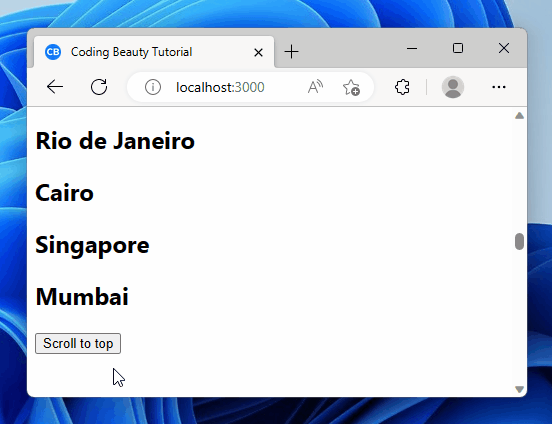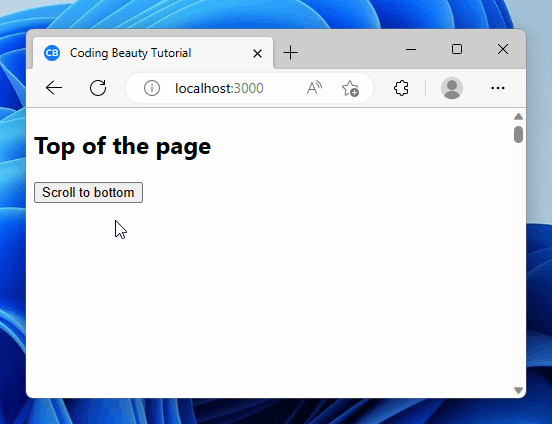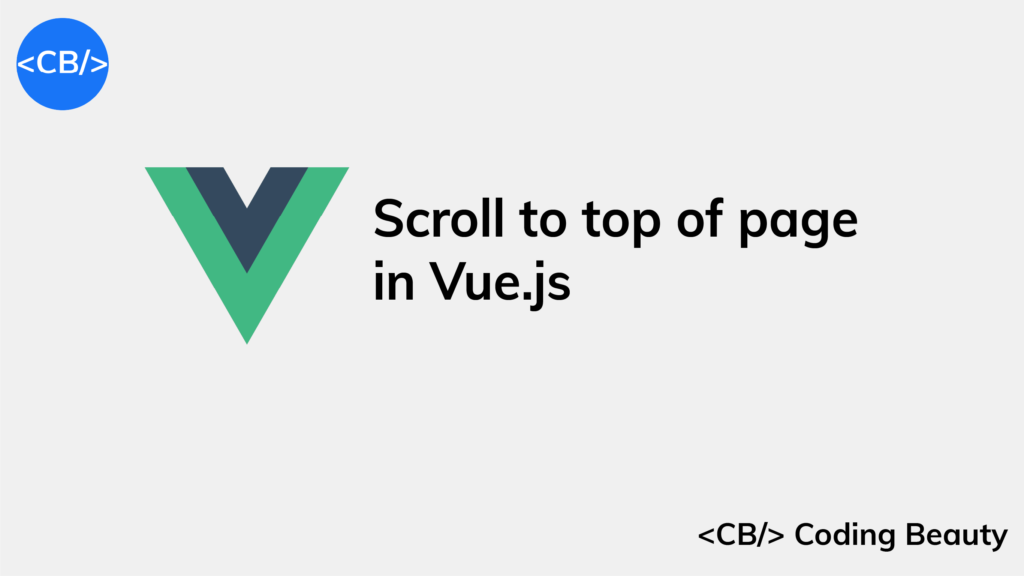To scroll to the top of a page in Vue.js, call window.scrollTo({ top: 0, left: 0}).
<template>
<div>
<h2>Top of the page</h2>
<div style="height: 100rem" />
<div ref="listOfCities">
<h2 v-for="city in allCities" :key="city">{{city}}</h2>
</div>
<button @click="scrollToTop">Scroll to top</button>
<div style="height: 150rem" />
</div>
</template>
<script>
export default {
data() {
return {
allCities: [
'Tokyo',
'New York City',
'Paris',
'London',
'Dubai',
'Sydney',
'Rio de Janeiro',
'Cairo',
'Singapore',
'Mumbai',
],
};
},
methods: {
scrollToTop() {
window.scrollTo({ top: 0, left: 0, behavior: 'smooth' });
},
},
};
</script>

The window.scrollTo() method scrolls to a particular position on a page.
We could have called it with two arguments: window.scrollTo(0, 0).
But this overload of scrollTo() doesn’t let us set a smooth scroll behavior.
When behavior is smooth, the browser scrolls to the top of the page in a gradual animation.
But when it’s auto, the scroll happens instantly. We immediately jump to the top of the page.
We use the @click directive of the button to set a click listener.
This listener will get called when the user clicks the button.
Scroll to bottom of page in Vue.js
We use a different approach to scroll to the end of the page in Vue.js.
We create an element at the end of the page.
We set a ref on it.
Then we scroll to it by calling scrollIntoView() on the ref.
<template>
<div>
<h2>Top of the page</h2>
<button @click="scrollToBottom">Scroll to bottom</button>
<div style="height: 100rem" />
<div>
<h2 v-for="city in allCities" :key="city">{{city}}</h2>
</div>
<div style="height: 150rem" />
<div ref="bottomElement"></div>
<h2>Bottom of the page</h2>
</div>
</template>
<script>
export default {
data() {
return {
allCities: [
'Tokyo',
'New York City',
'Paris',
'London',
'Dubai',
'Sydney',
'Rio de Janeiro',
'Cairo',
'Singapore',
'Mumbai',
],
};
},
methods: {
scrollToBottom() {
this.$refs.bottomElement.scrollIntoView({ behavior: 'smooth' });
},
},
};
</script>
scrollIntoView() scrolls to a specific element on the page.
By calling it on the bottom element, we scroll to the page end.
Like scrollTo(), scrollIntoView() has a behavior option that controls the scrolling motion.
scrollToBottom() {
this.$refs.bottomElement?.scrollIntoView({ behavior: 'smooth' });
}
smooth scrolls to the element in an animation.
auto jumps to the element on the page instantly. It’s the default.
To access the bottom element, we set a Vue ref on it.
To do this, we create a ref object and set the element’s ref prop to it.
<template>
<div ref="bottomElement"></div>
</template>
Doing this lets us access the element’s HTMLElement object with this.$refs.bottomElement.
Vue refs are a way to register a reference to an element or a child component.
The registered reference will be updated whenever the component re-renders.
Key takeaways
- In Vue.js, to scroll to the top of a page, call
window.scrollTo()with{ top: 0, left: 0, behavior: 'smooth' }. - Setting
behaviorto'smooth'makes a gradual animated scroll to the top.'auto'causes an instant jump to the top. - To scroll to the bottom of a page in Vue.js, call
scrollIntoView()on a specific element.
Create a ref for it using therefattribute first. - Vue refs are used to create a reference to an element.
This allows access to its properties during the component’s lifecycle.
Every Crazy Thing JavaScript Does
A captivating guide to the subtle caveats and lesser-known parts of JavaScript.

